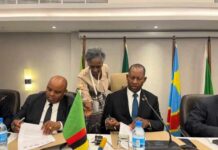THE livestock industry is one of the key sectors which has huge potential to contribute towards Zambia’s wealth creation and economic development.
As a result, the sector has remained a major source of income for many Zambians especially those living in rural areas.
Between 45 and 47 per cent of the rural population in Zambia depends on livestock for their livelihood.
A recent Parliamentary report shows that the current state of livestock farming in Zambia is worth over US$1.5 billion, accounting for around 35 per cent of agriculture share of national Gross Domestic Product (GDP).
The good news is that the sector has experienced steady growth in recent years.
Beef and dairy products are growing between seven per cent and 10 per cent annually respectively.
The poultry industry has also doubled in size over the last 10 years.
Despite its huge potential for growth, development of the livestock sector in Zambia has been stifled by a number of barriers.
The sector continues to face many challenges which include inadequate development funding and taxation from Government, rampant livestock disease outbreaks; poor disease control mechanisms; poor supply of breeding stocks; high cost of cheap and long term finance and poor infrastructure such as roads.
Other challenges include lack of processing facilities in form of abattoirs and milk collection centres, among others, high energy costs,shortage and high cost of feedstock, absence of input
support, inadequate and inappropriate research, poor extension support, poor organisation of marketing services and high number of levies on livestock and livestock products.
There’s currently no livestock development policy to deal with these challenges but Government is in the process of developing one.
The exact numbers of livestock in the country are not known and without proper data it is challenging to formulate strategies that addresses the key problems.
On the other hand, Zambia, cannot export beef not because of small cattle population in the country but due to a livestock sector which has continuously been ravaged by disease outbreaks.
The Zambia National Farmers Union (ZNFU) says Zambia’s beef production has been plagued by disease outbreaks affecting its productivity and exports.
The country’s cattle population stands at about three million animals with 20.3 million hectare of land identified as suitable for livestock grazing.
But disease outbreaks are a serious challenge because diseases such as foot-and-mouth and contagious bovine pleuropneumonia have continued decimating cattle at an alarming rate.
The Zambian livestock sector cannot meet local demand and this is why even imports are allowed because with a population of about three million animals, supply has failed to meet demand.
Zambia should be able to grow its herd to meet local demand and create room for exports.
Government’s decision to put up measures that will prevent cattle diseases from spreading to areas that are currently disease-free as announced by Minister of Agriculture and Livestock Robert Sichinga is welcome.
The ministry is aware that some parts of the country have recently been hit by outbreaks of animal diseases and Government says it will not sit back and watch livestock go to waste.
In 2011 and 2012 there were various requests for imports of choice and standard beef and meet carcasses because of the failure by local beef suppliers to meet demand.
Agriculture and Livestock deputy minister Luxon Kazabu said the country had a lot to learn from Botswana to boost the dairy and livestock sectors.
“We must as a country strive hard to penetrate the European market in terms of exporting beef. like our friends in Botswana, the country is a desert but it’s the largest exporter of beef in Africa,” Mr Kazabu said.
He said cattle diseases were a setback in the country’s quest to become an exporter of beef.
“We just need to rehabilitate the dip tanks. That is also an obstacle because these tanks are located very far from where our people live, so by adding to the number of dip tanks that we already have, I think we will be shortening the distance.
Going forward, we have to look at how best we can support our people especially those in the countryside who do not have enough money to see how best we can help them so that they too can dip their cows.
Because in the villages, the grazing of cattle is communal, so if one person is dipping his animals and the rest are not, I think that is a futile mission because the cattle will mix and in the process even the ones that are dipped will pick up some disease,” he said.
Once the Government addresses cattle diseases as it has promised, this will enable it to lift the ban on the movement of cattle to encourage more competition and help traditional cattle owners to improve their standard of living.
With over 20.3 million hectares of land available for grazing, the country can grow its cattle population so that Zambia can start earning foreign currency from livestock.
As a country we have been talking about diversification for a very long time with very tangible results and addressing animal diseases will go a long way in helping the country to reduce its dependence on copper.
The decision by the Ministry of Agriculture and Livestock to enhance diversification by ensuring that Zambia’s livestock sector becomes competitive and disease-free is welcome as it will help the sector contribute to the growth of the agriculture sector and eventually contribute to the growth of the economy.
Commercial and small-scale producers are now investing in breeding stock by buying female animals due to the high beef prices.
Beef prices have gone up due to limited supply which has been failing to satisfy the local market as demand increases because of a growing middle class.
The livestock sector was neglected by the previous administration but Government wants to revive the sector through introduction of deep tanks and constant vaccinations to avoid diseases.
ZNFU said “We are sure that with the introduction of such services, our livestock sector will start contributing to Zambia’s GDP to help grow our economy and reduce poverty.”
The Central Veterinary Research Institutes (CVRI) urged farmers to be vigilant on animal diseases to report to relevant authorities in the quest to eradicate outbreaks.
Institute Veterinary Research officer Benson Bowa said disease outbreaks are a threat in developing the livestock sector and that farmers should report to veterinary officers as soon as they suspect a disease outbreak among their animals.
“Farmers should also participate in eradicating disease outbreaks. They shouldn’t just sit and wait until their animals start dying.
“They should report to veterinary livestock officers in their districts as soon as they suspect there is a disease outbreak to prevent the diseases from spreading, these diseases are a threat to the development of our livestock sector,” he said.
Dr Bowa said once farmers report such cases before the disease spreads, it is easy for the officers to institute control measures.
He said the institute has been supporting livestock disease control through the provision of research activities and continuous training of farmers.
There is need for Zambia to be aggressive and position itself as a regional beef exporter.
And former Ministry of Agriculture and Livestock deputy Minister Nicolas Banda said Government was determined to finding best ways and resources to invest in the livestock sector aimed at controlling animal diseases.
Mr Banda said issues of animal disease had hampered the livestock sector for years, posing a huge challenge on the country’s ability to export beef products.
“As a country, we have not been able to export beef products because of animal diseases as a ministry and as a government we are determined to have this situation corrected,” he said.
Mr Banda said the Ministry of Agriculture was determined to make sure that the livestock sector was able to hit the acceptable standards of meat products, including milk production.
“We need to plan and sensitise our farmers to diversify other than just the mono crop of maize, we want our farmers at every level to do a mixed kind of farming; we are encouraging them to keep livestock,” he explained.
Mr Banda said economically, people keeping livestock made more money compared to those with just about 10 hectares of a maize field, adding that such kind of economic strides needed to be understood by farmers.
He urged farmers not to stop growing maize completely because it was the country’s staple food but to diversify as well.
“It is important to continue growing the crop to feed other countries in the region.
As Zambia, we have been recording bumper harvests but we can also improve on the storage for the grain facilities so that the quality of grain is maintained after harvest and for it to also hit a good market locally and international and our effort should be in that direction,” Mr Banda said.

 JOIN DRIVERN TAXI AS PARTNER DRIVER TODAY!
JOIN DRIVERN TAXI AS PARTNER DRIVER TODAY!











